

Creating Characters. 3 Strategies to Improve Student Writing Instantly. Editor's Note: A version of this post first appeared on Techie Teacher and Character Coach.

"But Miss Parrish, I can't think of anything to write! " Haven't we all heard similar lines in our classrooms? Close reading: best practices and next practices. Let’s call her Nadia.

I’ve been working with her one on one for a little over a year now. “I suck at reading,” she told me bluntly, when she approached me for help toward the end of her sophomore year. Textual Evidence on Pinterest. Strategies and Resources for Supporting English-Language Learners. "The hardest part of living in a different country is the language barrier.

Because you know you have to learn the language in order to survive. " – Betina Johnson Being an English-language learner in the United States is no honeymoon. Efforts to support ELLs have often been well meaning but misinformed. Indeed, a lot of assumptions about how to serve ELLs need to be checked. UC Berkeley experts Margaret Bridge and Bruce Fuller offer three examples of these faulty assumptions: The expectation that Mexican-American English-language learners would enter U.S. schools with inadequate social competence turned out not to be realized.
What About Grammar Drills? Everyone agrees that ELLs need help in mastering "the basics" of grammar usage. 10 Reasons to Do an Author Study. 1.
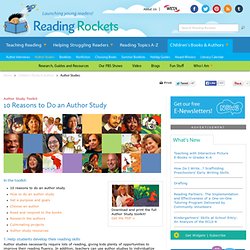
Help students develop their reading skills Author studies necessarily require lots of reading, giving kids plenty of opportunities to improve their reading fluency. In addition, teachers can use author studies to individualize reading instruction by grouping students according to their reading levels and helping them choose an appropriate author to study. 2. Build critical thinking skills. Fishtree Education on Twitter: "The 4-Step Guide To Critical Thinking Skills #21stedchat #cpchat... Digital Tools for Pairing Literary and Informational Texts and Close Reading Skills. Dr.
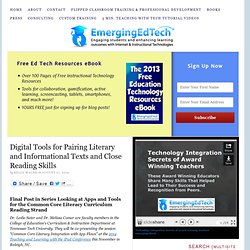
Leslie Suter and Dr. Melissa Comer are faculty members in the College of Education’s Curriculum & Instruction Department at Tennessee Tech University. They will be co-presenting the session “Common Core Literacy Integration with App Flows” at the 2014 Teaching and Learning with the iPad Conference this November in Raleigh, NC. 15 terrific resources for close reading. Snap Learning is a longtime partner and supporter of The Cornerstone, and they have sponsored this post.
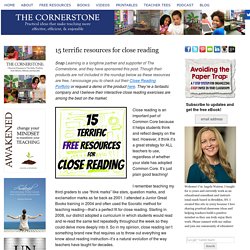
Though their products are not included in the roundup below as these resources are free, I encourage you to check out their Close Reading Portfolio or request a demo of the product here. They’re a fantastic company and I believe their interactive close reading exercises are among the best on the market. Close reading is an important part of Common Core because it helps students think and reflect deeply on the text. However, it think it’s a great strategy for ALL teachers to use, regardless of whether your state has adopted Common Core. It’s just plain good teaching! I remember teaching my third graders to use “think marks” like stars, question marks, and exclamation marks as far back as 2001. 20 Charts to Help You Teach Close Reading. 21 Cool Anchor Charts To Teach Close-Reading Skills.
Edutopia sur Twitter : "Some tried-and-true strategies from a veteran educator: #k12... Evaluating and Vetting Common Core "Aligned" Close Reading Materials. 4-ways-to-differentiate-learning-and-engage?utm_content=buffer4427a&utm_medium=social&utm_source=twitter. Close Reading, Part Two: Visual Literacy through Photography. By Frank W.
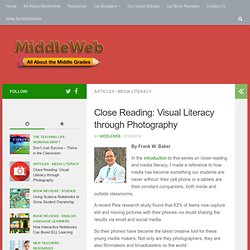
Baker In the introduction to this series on close reading and media literacy, I made a reference to how media has become something our students are never without: their cell phone or e-tablets are their constant companions, both inside and outside classrooms. A recent Pew research study found that 83% of teens now capture still and moving pictures with their phones–no doubt sharing the results via email and social media. So their phones have become the latest creative tool for these young media makers. Not only are they photographers, they are also filmmakers and broadcasters–to the world. But while many understand how to operate these so-called “smart phones,” they don’t always receive instruction in the rules of photography or visual literacy. The new Common Core teaching standards, endorsed by a majority of states, now make many references to understanding illustrations, but mostly in the elementary grades: these references all but disappear in secondary schools. Frank W. 8 Characteristics of The 21st Century Teacher.
6 Tools for Teachers. Technology has changed a lot about the way we live and work, but one area stands out as an exception: education.

Many teachers still have to use the same tools—blackboards, textbooks, overhead projectors—that their own teachers used decades ago. The 6 Levels Of Bloom's Taxonomy, Explained With Active Verbs - Edudemic. The 5 Step Model to Teach Students Critical Thinking Skills. 249 Bloom's Taxonomy Verbs For Critical Thinking.
Bloom’s Taxonomy’s verbs–also know as power verbs or thinking verbs–are extraordinarily powerful instructional planning tools.

In fact, next to the concept of backwards-design and power standards, they are likely the most useful tool a teacher-as-learning-designer has access to. Why? They can be used for curriculum mapping, assessment design, lesson planning, personalizing and differentiating learning, and almost any other “thing” a teacher–or student–has to do. For example, if a standard asks students to infer and demonstrate an author’s position using evidence from the text, there’s a lot built into that kind of task. First a student has to be able to define what an “author’s position” is and what “evidence from the text” means (Knowledge-level). Though the chart below reads left to right, it’s ideal to imagine it as a kind of incline, with Knowledge at the bottom, and Create at the top.
6 Scaffolding Strategies to Use with Your Students. What’s the opposite of scaffolding a lesson? Saying to students, “Read this nine-page science article, write a detailed essay on the topic it explores, and turn it in by Wednesday.” Yikes! No safety net, no parachute—they’re just left to their own devices. Let’s start by agreeing that scaffolding a lesson and differentiating instruction are two different things. Scaffolding is breaking up the learning into chunks and providing a tool, or structure, with each chunk. Simply put, scaffolding is what you do first with kids. Scaffolding and differentiation do have something in common, though.
So let’s get to some scaffolding strategies you may or may not have tried yet. 1. How many of us say that we learn best by seeing something rather than hearing about it? Try a fishbowl activity, where a small group in the center is circled by the rest of the class; the group in the middle, or fishbowl, engages in an activity, modeling how it’s done for the larger group. 2. 3. 4. K-12 Resources for Students. Text Complexity Workshop Resources. Writing to Text. Content Literacy Resources. The Heart of the Close Reading Standard - Amherst, NY, United States, ASCD EDge Blog post. Has Close Reading Gone Amok? (Part 2) Understanding the Essence of a Close Read. Writing prompts: Archive. Reading Workshop Strategies.
Reading Workshop is a powerful way to structure your reading class.
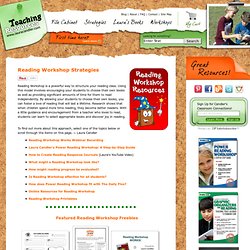
Using this model involves encouraging your students to choose their own books as well as providing significant amounts of time for them to read independently. By allowing your students to choose their own books, you can foster a love of reading that will last a lifetime. Research shows that when children spend more time reading, they become better readers. With a little guidance and encouragement from a teacher who loves to read, students can learn to select appropriate books and discover joy in reading. To find out more about this approach, select one of the topics below or scroll through the items on this page. ~ Laura Candler. Online Sources for Informational Text. @coolcatteacher Blog - Teach with better results, lead with a positive impact and live with greater purpose. Share My Lesson - Free K-12 Lesson Plans & Teaching Resources.
Supporting-instruction-cards-literacy. Tutorial on how to get the most out of ReadWorks.
Information Text Practice. Writing. ReadWorks Now Offers Poems and Question Sets for K-12 Classrooms. ReadWorks is a free service that I have been recommending for about a year now. It provides teachers with hundreds of lesson plans and more than two thousand reading non-fiction and fiction passages aligned to Common Core standards. Recently, ReadWorks expanded again. The latest expansion includes poems and question sets. The collection is organized by grade level. In the collection you will find poems by Frost, Dickinson, Stevenson, and other notable poets. Applications for Education One of the aspects of ReadWorks that I like is that lexile scores are listed for each article along with grade levels and Common Core standards.